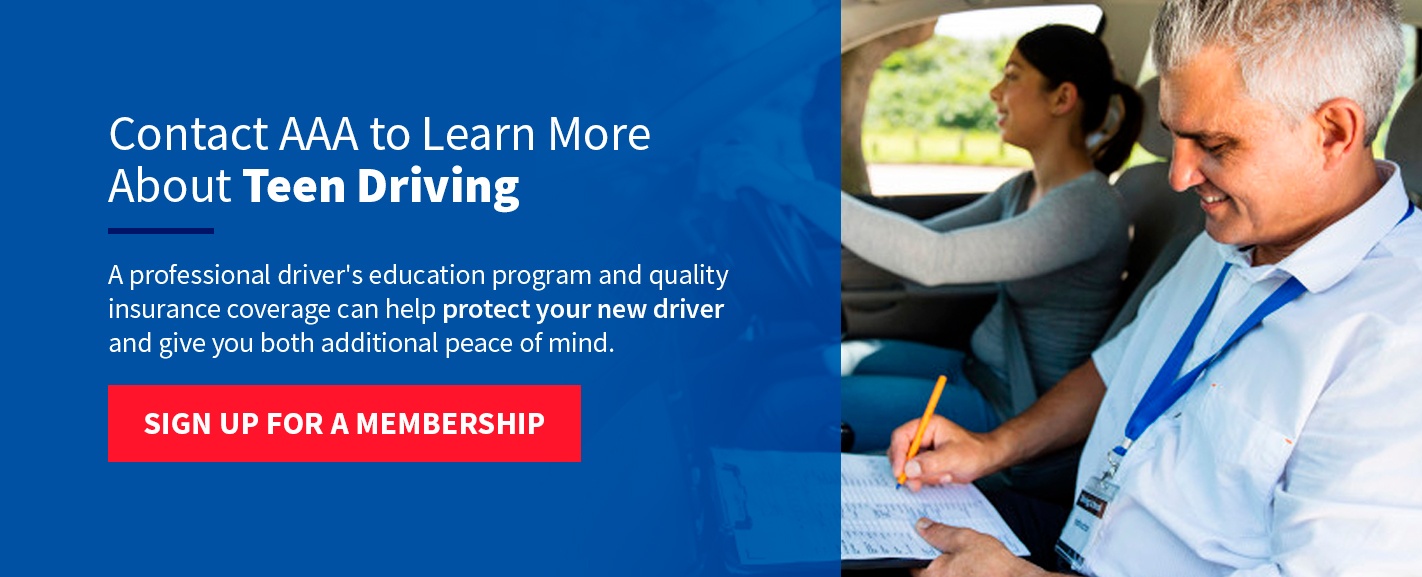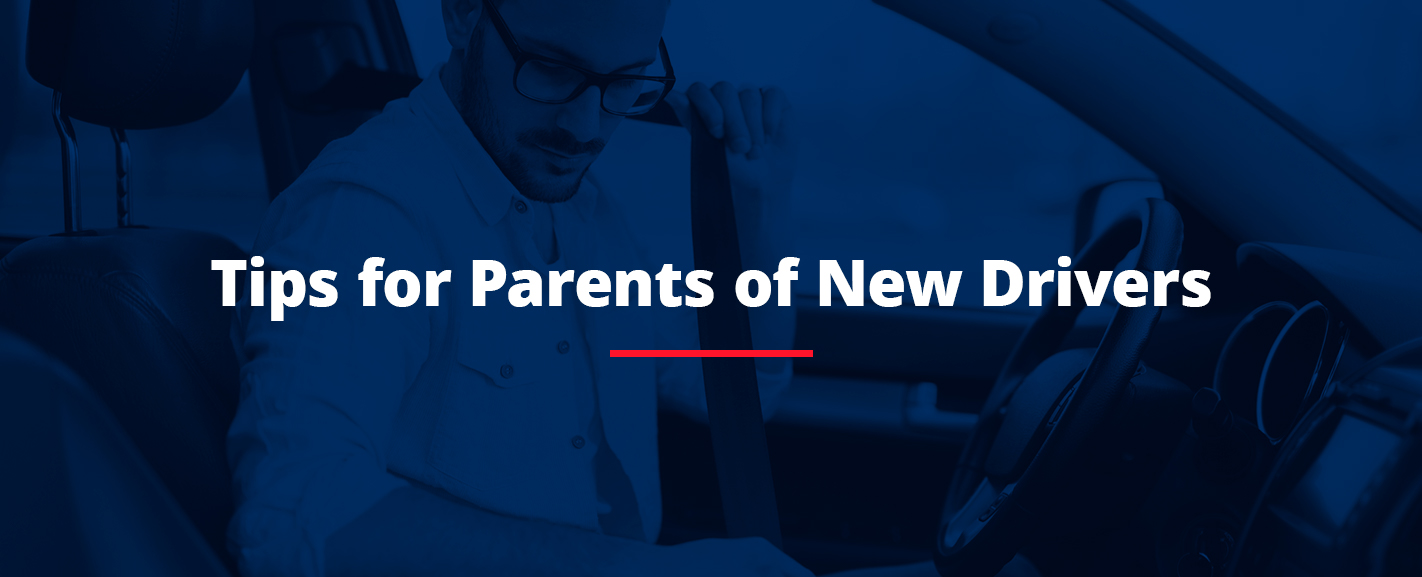
Teaching your teen how to drive is an exciting time. You are helping them take the steps they need to become a more self-sufficient, responsible person. Learning how to drive is likely even more of a thrill for your teen, who is ready to experience the freedom and independence of the open road. Teaching your teen how to drive for the first time can be overwhelming if you're unsure where to begin, so we've created a list of helpful tips and essential information to make the learning process go smoothly for you and your new driver.
Read the full article or skip to a specific section:
- 1. Take a Step Back and Relax
- 2. Be an Example for Your Child
- 3. Ensure Your Car Is Safe and Ready to Drive
- 4. Realize That Practice Makes Perfect
- 5. Choose Safe Road Conditions to Begin
- 6. Discuss What Not to Do While Driving
- 7. Gradually Prepare Them for Weather Changes
- 8. Find a AAA-Recommended Driver's Ed Program
- 9. Have Full-Coverage Car Insurance
- Contact AAA to Learn More About Teen Driving
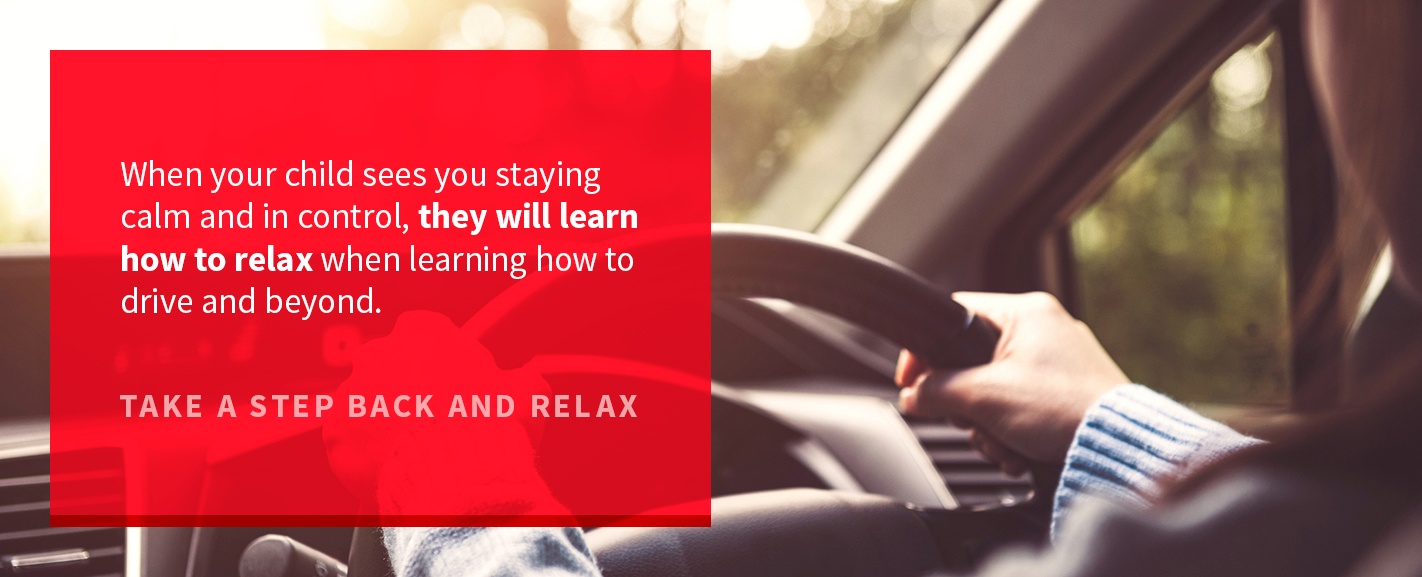
1. Take a Step Back and Relax
For your first few practice sessions behind the wheel, emotions will be running high for you and your teen driver. While it's natural to feel anxious from the passenger seat, it's vital you stay relaxed and collected while your teen is driving. When your child sees you staying calm and in control, they will learn how to relax when learning how to drive and beyond.
Some ways to do this include the following.
- Keeping an eye on your emotions: Take deep breaths and keep your emotions in check. At the same time, check on your teen — how are they doing? Do they seem panicked, emotional or overwhelmed? If so, encourage them to stay calm and find a safe spot to pull over if necessary. Though gentle correction is a part of the driver education process, refrain from arguing with each other to minimize distractions and keep tensions low. Save non-time-sensitive feedback for when you get home.
- Eliminating distractions: Eliminate unnecessary distractions during your driving practice sessions, including silencing your cellphones and keeping the radio at a low volume. For the first few sessions, try to practice one-on-one with your child and keep pets and other passengers out of the car.
- Getting some fresh air: If your teen feels overwhelmed, consider rolling down the window for a light breeze and sunshine. Studies have found fresh air can have a positive effect on people's moods.
- Taking a new route: If you find it hard to relax on busy city roads or fast-paced highways, suggest finding a smaller, more scenic path for a little while. The change in scenery and slower pace will allow both you and your child a chance to relax a little bit and recollect yourselves before tackling larger roads again.
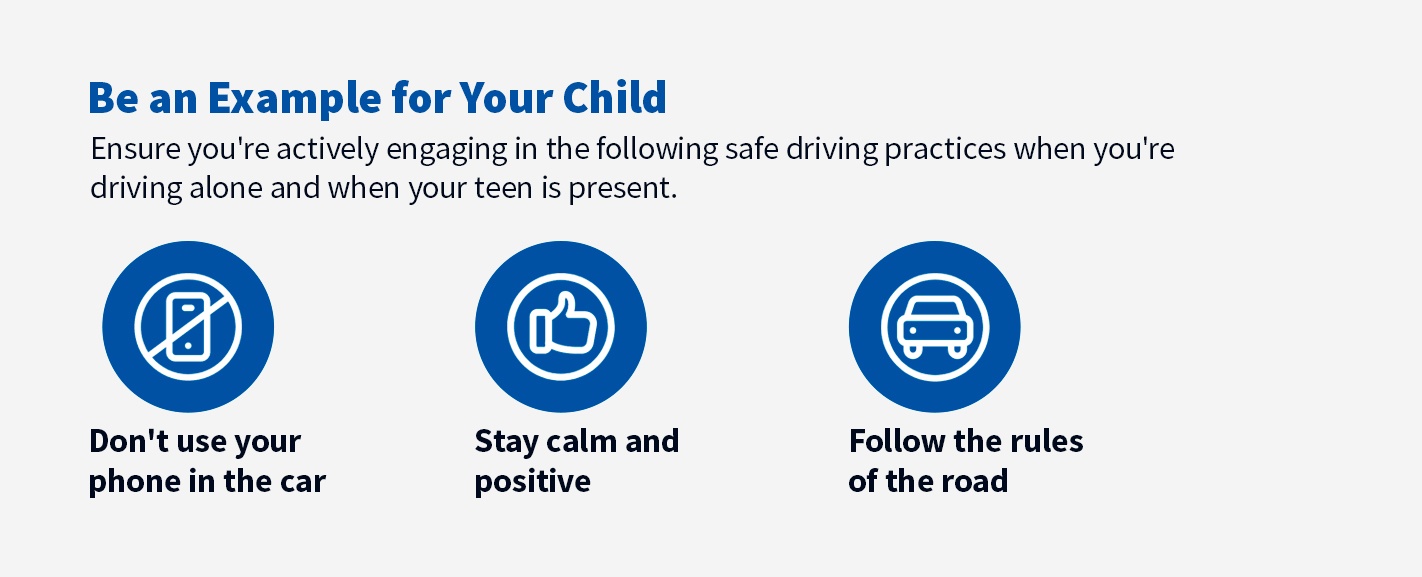
2. Be an Example for Your Child
One of the best tips for parents of new drivers is to lead by example. You can't effectively teach your child everything they need to know about road safety if they see you doing the opposite. Try to be a good example when you're behind the wheel and when you're the passenger.
Ensure you're actively engaging in the following safe driving practices when you're driving alone and when your teen is present.
- Don't use your phone in the car: Cellphones — even when using hands-free devices — are a major distraction for both you and your teenager, no matter who is driving. Make your practice time a phone-free zone, so you can focus your undivided attention on your child. When you're the one driving, always keep your phone silenced and never text or accept phone calls.
- Stay calm and positive: Instead of giving in to road rage, show your teen how to stay calm and positive during frustrating road experiences. Resist the temptation to react out of anger, and instead use it as a teaching opportunity.
- Follow the rules of the road: When you're driving, let your teen see you sticking to the road rules. Always keep your hands on the steering wheel, signal before turns, wear your seat belt and drive the speed limit. If they see you break any of these rules, they will start to make exceptions for themselves, which is a dangerous habit.
Consider collaborating with your child on a parent-teen driving agreement contract. Create a list of non-negotiable rules and consequences and different milestones and goals your child can try for. For example, consider rules like "all passengers must wear a seat belt" or "avoid driving after dark in the winter." Use this space for you and your teen to express their concerns. For your part of the agreement, be sure to include a section promising you will practice all the safe practices you teach, and that you will do your best to guide and coach, rather than scold.
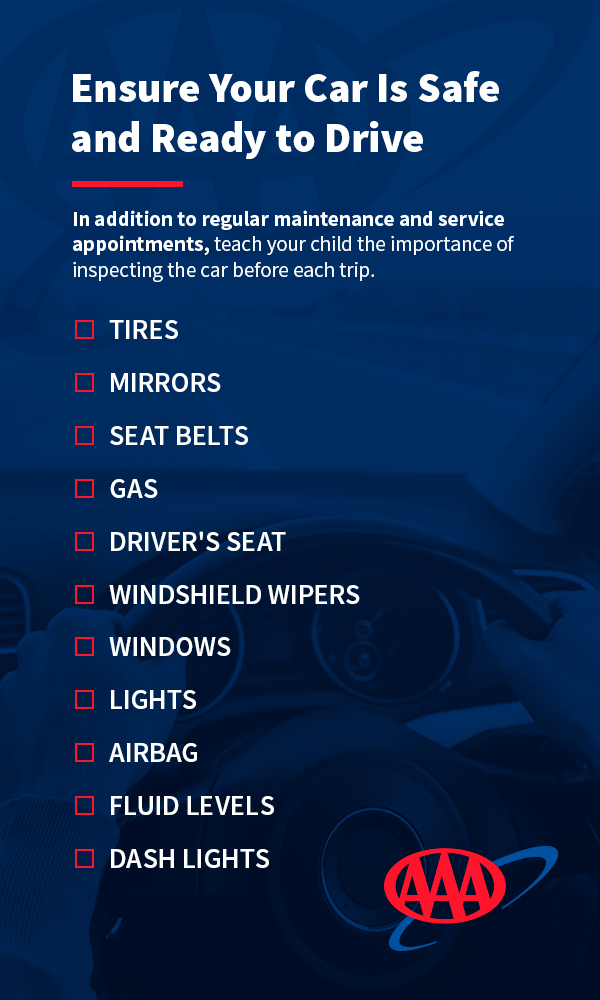
3. Ensure Your Car Is Safe and Ready to Drive
The safer the car is, the less reason you have to be worried when your teen driver leaves the house. In addition to regular maintenance and service appointments, teach your child the importance of inspecting the car before each trip. Here are some crucial areas to look at.
- Tires: Check that you have all four tires and the spare tire inflated to the correct level. Refill if needed.
- Mirrors: Have your teen adjust the rearview and side mirrors to their eye level, and make sure they are free of smudges and dirt.
- Seat belts: Check that all seat belts work, especially if transporting passengers.
- Gas: Fill the gas tank with enough fuel to get to the next destination, with some extra in case of emergencies or wrong turns.
- Driver's seat: Adjust the wheel and seat to match your teen's height.
- Windshield wipers: Make sure the windshield wipers work and have fluid.
- Windows: Clear away all dirt and obstructions from each window.
- Lights: Check that all interior and exterior lights work, including turn signals and emergency flashers.
- Airbag: Check whether the airbags are enabled.
- Fluid levels: Note fluid levels — including brake and engine oil — and replenish if necessary. Never drive with a fluid leak present.
- Dash lights: Address any warning lights on the dash, including low tire pressure or unlatched doors and hatchbacks.
It's not enough to list or check these areas yourself. Take time to teach your child how to inspect each of these things, recognize any issues and what to do if something isn't working correctly.

4. Realize That Practice Makes Perfect
Are you looking for driving tips for nervous drivers? Nothing defeats first-time driving jitters like getting plenty of practice. The more time your teen spends behind the wheel, the more comfortable they will become. More time on the road also means you'll encounter a variety of different driving scenarios, which provide valuable experience for a new driver.
Before you begin driving lessons, sit down with your teen and create a plan. Set aside time each week to go driving together, and keep track of any areas they want to focus on or improve over the next several drives. When it comes time for the drive, remember to stay calm and focused. Stick to your planned route and avoid last-minute turns or changes without discussing it with your driver. Instead of telling or warning your child of a mistake, consider phrasing it as a question, like "When should you turn on your turn signal for our exit?" or "How far should you stay behind this vehicle?"
Remember to practice patience — while you might have been doing this for decades, this is all new for them. The better experience you create during practice drives, the more willing your teen will be to keep trying.
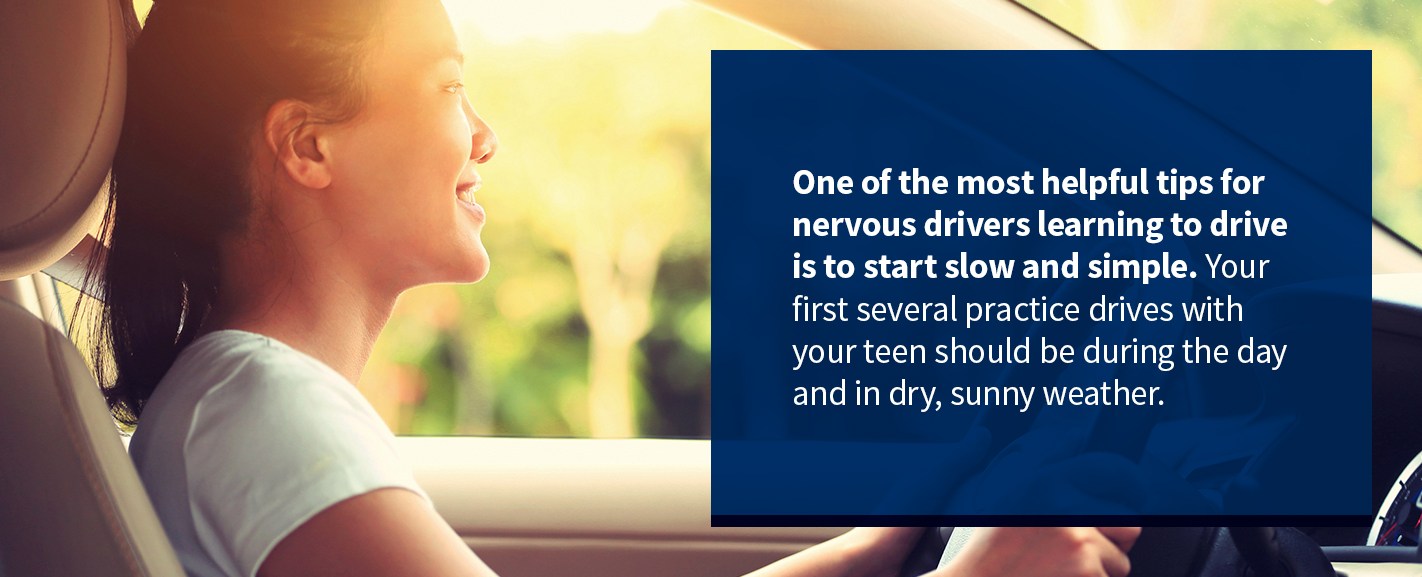
5. Choose Safe Road Conditions to Begin
One of the most helpful tips for nervous drivers learning to drive is to start slow and simple. Your first several practice drives with your teen should be during the day and in dry, sunny weather. Let them build experience and confidence during optimal road conditions before introducing more challenging ones. For the first few drives, choose paved, two-lane roads and gradually work your way up to narrow roads, dirt or backroads and multi-lane highways.

6. Discuss What Not to Do While Driving
Teach your teen the clear boundaries between what is and is not OK to do while driving. Two of the most common and problematic driving habits to discuss are distracted driving and driving under the influence, which can lead to traffic violations, suspended or revoked driver's licenses and higher car insurance rates or accidents.
Distracted Driving
In 2018, there were nearly 400,000 people injured in distraction-related incidents. Distracted driving manifests itself in many different forms. You can categorize a driving distraction as either visual, auditory, manual or cognitive.
- Visual: Visual distractions are anything that takes your eyes off the road, like looking at billboards and attractions, pedestrians, a cellphone or passenger.
- Auditory: Auditory distractions can be just as dangerous as visual ones, especially if a driver's surroundings are too loud to let them hear and concentrate on traffic. Common auditory distractions include excessively loud music or hands-free phone calls. Noisy passengers can also be a distraction, so many states have limits and restrictions against teen drivers having too many other people in the car.
- Manual: Manual distractions take a driver's hands off the steering wheel, and are to blame for many avoidable accidents. Avoid texting, fiddling with the radio or AC, eating, digging in your bag or center console and bending to pick up fallen objects.
- Cognitive: When a driver isn't thinking clearly, it's more challenging to focus on the road and stay present. Cognitive distractions include daydreaming, losing focus or driving when emotionally distressed.
These driving distractions are more than harmful — they may even be illegal. Most states have restrictions against some form of distracted driving, including texting.
Driving Under the Influence
Safe driving means giving all your attention to the road ahead and scanning for other cars and pedestrians. The influence of drugs, alcohol or drowsiness dulls your senses, slows your reaction time and compromises your focus.
To keep your teen and others safe, warn them about the genuine dangers of the following.
- Drugs or alcohol: Driving under the influence of drugs and alcohol makes it impossible to drive safely and puts others at risk. It's also illegal and can cost your driver their license, or worse. While teens frequently hear that driving under the influence is wrong, take time to have a real conversation about it. Explain the real-life consequences of these actions, including crashes, injury and loss of life. Provide them with practical alternatives to driving if they need to get home safely. This conversation is also an excellent opportunity to talk about the dangers of riding with an intoxicated driver.
- Drowsiness: Drugs and alcohol aren't the only dangerous influence — falling asleep behind the wheel accounts for thousands of accidents each year. Drowsy driving makes it more challenging to pay attention to the road and slows reaction time significantly. According to the National Highway Traffic Safety Administration, those at risk for engaging in sleep-related incidents include drivers between 17 and 23 years old, as well as those who get six or fewer hours of sleep at night. Drowsy driving is especially dangerous on back roads between midnight and 6 a.m.
Teach Safe Driving Techniques
Once you've had the conversations about what not to do while driving, you can focus on helpful and practical safe driving techniques that your child needs to succeed on the road. Teach them the basics, such as:
- What each road sign means.
- The importance of speed limits.
- How and when to signal a turn.
- What to do at intersections and stoplights.
- How to shift gears.
- How to park in all types of spots.
- How to reverse the car.
- How to change lanes or merge.
- What the appropriate safe driving distance is.
- How to turn around or perform a U-turn.
- How to scan and identify possible hazards and obstacles in the road.
- What to do in special circumstances, like taking an exit, crossing a railroad or passing through a toll booth.
- How and when to pass other drivers.
- How to apply the gas and brakes gently.
- Unwritten road etiquette, like waving when someone lets you into the road and letting faster cars pass when necessary.
- How to identify and navigate blind spots.
In addition to these driving basics, teach your teen how to change a tire and give them the phone number for a local towing company or your AAA membership information. Make sure they know to keep their license, registration and insurance documentation in the car or on them at all times.
7. Gradually Prepare Them for Weather Changes
Once your teen has mastered driving in fair weather, gradually prepare them to operate in more challenging road conditions, including after dark, in heavy rain, in periods of fog or low visibility and on snowy and icy roads. When venturing out in poor weather, take only short drives in a familiar area to stay as safe as possible. Encourage your child to drive as slowly as they need to maintain control and feel comfortable. Use this time to teach them how to identify potentially dangerous spots, like black ice or submerged roadways, and how to navigate those situations safely.
Make sure your teen's car has an emergency supply kit on board. Fill it with essentials like:
- Road flares.
- Jumper cables.
- Flashlight and batteries.
- A blanket.
- An auto tool kit.
- A first-aid kit.
- A rain poncho.
- A reflective vest.
- A snow brush and shovel.
- Extra windshield washer fluid.
- Extra socks, gloves and winter layers.
- Sand or cat litter for road traction.
- Tire chains and a tow strap.
- Window cleaner and a microfiber cloth.
- Bottled water.
- A tire gauge.
- A window breaker tool.
- A paper map.
Go over these items with your new driver, including when and how to use them in an emergency.
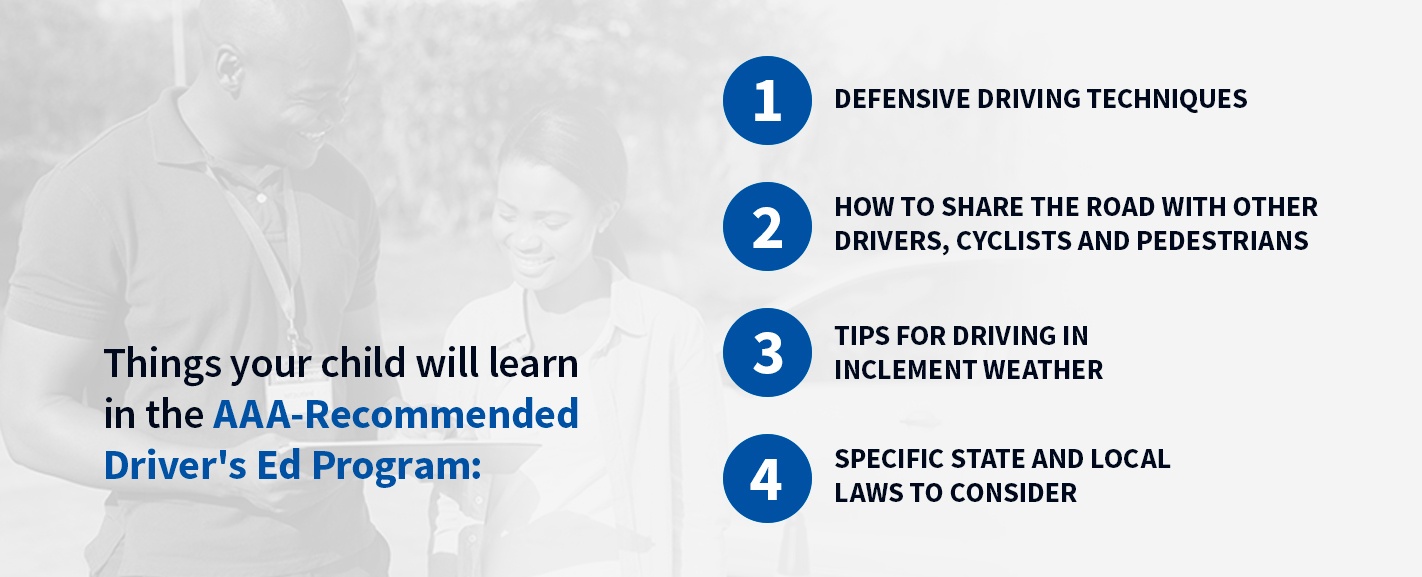
8. Find a AAA-Recommended Driver's Ed Program
Not sure how to teach a scared teenager to drive? Let a driver's education program help. Driver's ed is a series of classes conducted either virtually or in person that teach your child the techniques, laws and skills needed to stay safe. After your teen has completed all classes, they may transition to maneuverability or a hands-on driving program. Many states require driver's education before they will issue anyone a driver's license.
Things your child will learn in driver's ed include:
- Defensive driving techniques.
- How to share the road with other drivers, cyclists and pedestrians.
- Tips for driving in inclement weather.
- Specific state and local laws to consider.
In addition to these essential skills, driver's ed also exposes your teen to peers their age who might be feeling similar fears or anxieties about driving. AAA-recommended driver's education programs have well-maintained cars, up-to-date training materials, strong records of good practices and professional instructors.
9. Have Full-Coverage Car Insurance
Car insurance offers you and your teen peace of mind, knowing you do not have to manage the unexpected costs of an accident or fender bender alone. Quality insurance coverage is crucial for new drivers, because no matter how much they prepare or how responsible they are behind the wheel, you have no way of predicting others' behavior. Ask your current auto insurance provider about adding your new driver to your existing plan, or consider talking with your teen about purchasing a policy for themselves.
Look for new driver-related discounts, such as:
- Good grade discounts.
- Discounts for participating in additional driving courses beyond driver's ed.
- Affordable plans for used vehicles.
- Discounts for drivers with clean records.
- Bundle options with existing insurance plans.
Contact AAA to Learn More About Teen Driving
Teaching your teen how to drive is a crucial and exciting time for both of you. With the help of a calm attitude and plenty of open conversations, you can teach your child what it means to drive safely and the importance of staying alert on the road. A professional driver's education program and quality insurance coverage can help protect your new driver and give you both additional peace of mind.
A membership with AAA provides several perks you and your new driver will love, such as the following.
- Automotive services: Worried about your teen getting a flat tire, dead battery or accidentally getting locked out of their car? AAA automotive services are there to help with comprehensive coverage and 24/7 assistance.
- Driver education: AAA members and their children get exclusive access to training courses and seminars to teach your driver what they need to know to get their license.
- Travel planning and discounts: AAA can help you plan vacations and other travel, including securing passports, travel insurance and tickets to events and attractions. When you pair these planning services with the thousands of discounts available to AAA members on things like rental cars and hotels, travel-related stress becomes a thing of the past.
- Financial services and insurance: With a AAA membership, get access to financial products and services, as well as customized insurance coverage that you can bundle and tailor to fit all your needs.
- Emergency roadside assistance: When you have a AAA membership, you have peace of mind whenever you're on the road. With our emergency roadside assistance, you get access to battery services, tire repair and more.
Visit us online to learn more helpful advice for first-time drivers, or contact a AAA representative to learn more about what a AAA membership can do for you and your family.


